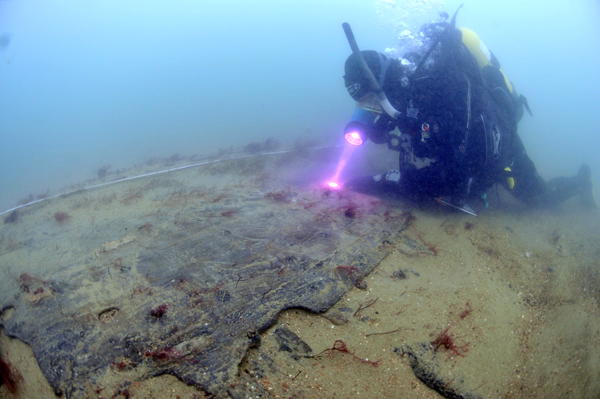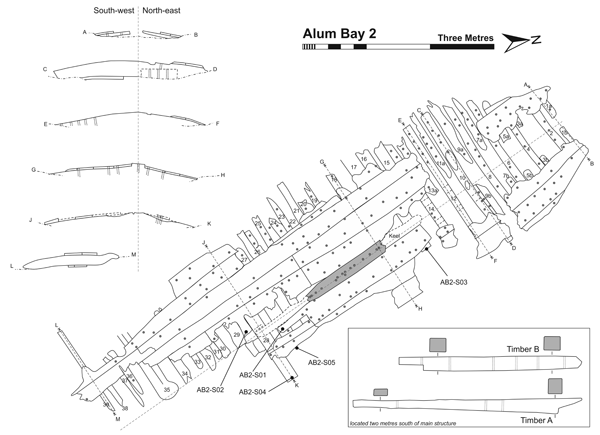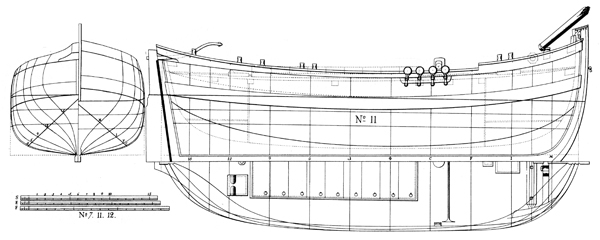In 2001, following reports from a local dive centre of a further wreck in Alum Bay, the MAT set out to investigate. Initial searches located scattered pieces of timber, before the remains of Alum Bay 2 were eventually discovered. The site is located a short distance to the southwest of the section of HMS Pomone, leading to the immediate suggestion that the two sets of remains might be related in some way.
Between 2001 – 2003 the site was surveyed and a plan produced. In 2009 dendrochronological samples were collected which allowed the vessel to be dated; this work was done by Nigel Nayling (University of Wales Trinity Saint David). Further survey and monitoring 2010 – 2013 has allowed the condition of the site to be assessed and changes in the disposition of the wooden remains to be recorded.

Vessel Characteristics
The seabed remains of Alum Bay 2 measure about 9m in length by 2.5m wide and are oriented NW-SE. The vessel has been deposited upside down on the seabed, meaning that the visible remains comprise the underneath of the vessel and the outside of the outer planking. Where the planking has become degraded it was possible to record the frames of the vessel that survive underneath.
The vessel was built using a ‘frame-based’ technique, where the structural frame of the vessel is built first, before the planks are added afterwards. In the case of Alum Bay 2, the floor timbers were placed first, followed by the lower planking. After this, the futtocks were fitted onto the lower planks, overlapping the floors, further planks were then attached to the futtocks before the second futtocks and other timbers that have not survived would have been installed. This variant of frame-based building does not connect the floor and futtock timbers together and because of this the planks help strengthen the hull of the vessel.
All of the fastenings that have been recorded on the site are wooden treenails and these carry distinctive cross cuts on their heads in order to tighten them in their sockets. This method of tightening treenails is associated with southern English shipbuilding during the post-medieval period. Provisional analysis of the wooden structure indicates that the frames are made from oak and the planking from elm. The dendrochronology samples taken in 2009 from two of the frames have provided a provisional date of 1795 to 1799 and a felling location in southern England.

Identification & Interpretation
The identity of Alum Bay 2 is likely to remain unknown despite extensive research to try to identify the vessel. Initial suggestions were that the vessel might have been one of the boats from HMS Pomone (wrecked on the Needles in 1811) or from another vessel lost in the vicinity. However, analysis of the structural remains has concluded that the original Alum Bay 2 vessel would have been too large, both in its length and in the size of its frames, for a ship’s boat and so alternative identifications have been addressed.
Our current interpretation of Alum Bay 2 is that it is likely to represent the remains of a fairly small vessel, possibly a local fishing smack, small coastal trading vessel or even a small transport vessel commonly known as a hoy. Alum Bay 2 would have been 37-45ft in length, 12-15ft wide and about 60 tons, such a vessel would probably have been rigged with a single mast and a carried a small crew. The date of the wreck is very interesting as not many small vessels have survived and been recorded from this period in an underwater context. A limited number of vessels have been lost in the area of Alum Bay that fit the characteristics and date of Alum Bay 2 and one of these is the most plausible candidate. One of these is the Ann & Susannah that was built in Cowes in 1799 and traded between the Solent and the West Country until it was lost ‘on the coast by the Needles’ in 1821.

Monitoring & Management
The site of Alum Bay 2 is often covered by a thin layer of sand that provides some protection from erosion and also discourages marine organisms, such as shipworm (Teredo navalis), from attacking the wood. When the site was discovered (2001-03) it was quite well preserved, however, visits in 2010 – 2013 recorded some of the outer planking having been lost, with more timbers then exposed. Changes were occurring relatively rapidly on this site. A dive in 2019 included a brief inspection of the remains, with reports of a lot of further damage to the site, particularly loss of more outer planking.
The changes that can be seen over a relatively short period of time on a site such as Alum Bay 2 indicate the importance of the on-going monitoring of maritime archaeological remains as a means of understanding how to preserve and manage them.
